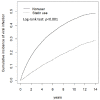Statin Therapy and the Risk of Viral Infection: A Retrospective Population-Based Cohort Study
- PMID: 36233493
- PMCID: PMC9571401
- DOI: 10.3390/jcm11195626
Statin Therapy and the Risk of Viral Infection: A Retrospective Population-Based Cohort Study
Abstract
Statins exert cholesterol-independent beneficial effects, including immunomodulatory effects. In this study, we attempted to investigate the association between statin therapy and the risk of viral infection. We conducted a retrospective cohort study using data from Taiwan's National Health Insurance Research Database. We identified patients with hyperlipidemia and divided them into two cohorts: statin users and statin nonusers. A 1:1 propensity score matching was conducted between the two cohorts, and a Cox proportional hazards model was used to evaluate the risk of viral infection. Overall, a total of 20,202 patients were included in each cohort. The median follow-up durations were 4.41 and 6.90 years for statin nonusers and users, respectively. The risk of viral infection was 0.40-fold (95% confidence interval = 0.38-0.41) in statin users than in statin nonusers after adjustment for potential confounders. Statin treatment was associated with a significantly lower risk of viral infection in all age groups older than 18 years in both men and women. Moreover, the risk of viral infection substantially reduced as the duration of statin treatment increased. Our findings suggest that statin therapy is associated with a significantly lower risk of viral infection in patients with hyperlipidemia.
Keywords: cohort study; epidemiology; propensity score matching; statin therapy; viral infection.
Conflict of interest statement
The authors declare that the research was conducted in the absence of any commercial or financial relationships that could be construed as a potential conflict of interest.
Figures
References
Grants and funding
LinkOut - more resources
Full Text Sources


